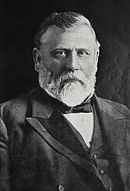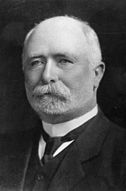1902 New Zealand general election
| ||||||||||||||||||||||||||||||||||
All 80 seats in the New Zealand House of Representatives 41 seats were needed for a majority | ||||||||||||||||||||||||||||||||||
|---|---|---|---|---|---|---|---|---|---|---|---|---|---|---|---|---|---|---|---|---|---|---|---|---|---|---|---|---|---|---|---|---|---|---|
| Turnout | 76.7% | |||||||||||||||||||||||||||||||||
| ||||||||||||||||||||||||||||||||||
| ||||||||||||||||||||||||||||||||||
The New Zealand general election of 1902 was held on Tuesday, 25 November, in the general electorates, and on Monday, 22 December in the Māori electorates to elect a total of 80 MPs to the 15th session of the New Zealand Parliament. A total number of 415,789 (76.7%) voters turned out to vote.[2]
The Rev Frank Isitt was nominated as the Prohibitionist candidate for ten separate electorates, and came second in eight. Another candidate, David Whyte, was nominated for two. Both men stood to ensure that a local liquor licensing poll was held in each electorate for which they were nominated.
1902 electoral redistribution
The Representation Act 1900 had increased the membership of the House of Representatives from general electorates 70 to 76, and this was implemented through the 1902 electoral redistribution. In 1902, changes to the country quota affected the three-member electorates in the four main centres. The tolerance between electorates was increased to ±1,250 so that the Representation Commissions (since 1896, there had been separate commissions for the North and South Islands) could take greater account of communities of interest. These changes proved very disruptive to existing boundaries.[3] Six electorates were established for the first time: Courtenay, Newtown, Grey Lynn , Hurunui, Oroua, and Kaipara. Two electorates that previously existed were re-established: Mount Ida and Hutt.[4]
This boundary redistribution resulted in the abolition of three electorates:[4]
- Ashley, held by Richard Meredith
- Suburbs of Wellington, held by Thomas Wilford
- Waihemo, held by Thomas Mackenzie
Results
Frank Isitt, a Methodist minister, stood in ten seats as a Prohibition candidate, and came second in eight.
Party totals
The following table gives party strengths and vote distribution according to Wilson (1985), who records Maori representatives as Independents prior to the 1905 election.[5]
style="width: 2px; background-color: #FFDF00;" data-sort-value="New Zealand Liberal Party" | style="width: 2px; background-color: #9999CC;" data-sort-value="Conservative (New Zealand)" | style="width: 2px; background-color: #DCDCDC;" data-sort-value="Independent politician" || Election results | ||||||
|---|---|---|---|---|---|---|
| Party | Candidates | Total votes | Percentage | Seats won | Change | |
| Liberal | 105 | 215,378 | 51.8 | 47 | -2 | |
| Conservative | 53 | 85,652 | 20.6 | 19 | ±0 | |
| Independent | 54 | 115,173 | 27.7 | 14 | +8 | |
Votes summary
Electorate results
Template:1902 New Zealand general election
Notes
- ^ Gustafson, Barry. "Massey, William Ferguson". Dictionary of New Zealand Biography. Ministry for Culture and Heritage. Retrieved 10 December 2011.
- ^ "General elections 1853-2005 - dates & turnout". Elections New Zealand. Archived from the original on 14 November 2014. Retrieved 12 January 2011.
- ^ McRobie 1989, pp. 67f.
- ^ a b McRobie 1989, pp. 63–68.
- ^ Wilson 1985, pp. 287–289.
Footnotes
References
- McRobie, Alan (1989). Electoral Atlas of New Zealand. Wellington: GP Books. ISBN 0-477-01384-8.
{{cite book}}: Invalid|ref=harv(help) - Wilson, James Oakley (1985) [First published in 1913]. New Zealand Parliamentary Record, 1840–1984 (4th ed.). Wellington: V.R. Ward, Govt. Printer. OCLC 154283103.
{{cite book}}: Invalid|ref=harv(help)


